2012 PEUGEOT 4007 display
[x] Cancel search: displayPage 106 of 236
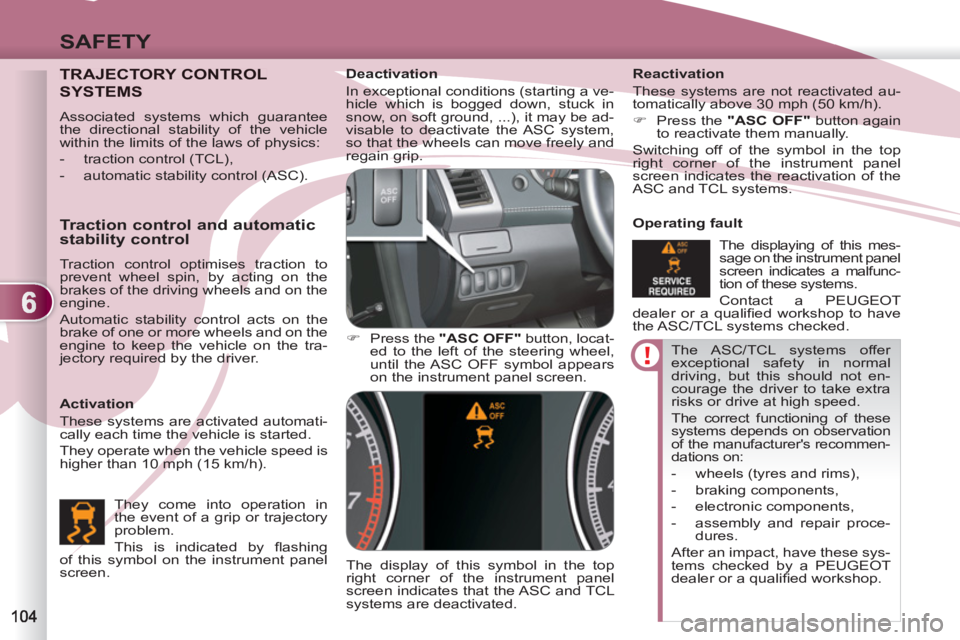
6
SAFETY
The ASC/TCL systems offer
exceptional safety in normal
driving, but this should not en-
courage the driver to take extra
risks or drive at high speed.
The correct functioning of these
systems depends on observation
of the manufacturer's recommen-
dations on:
- wheels (tyres and rims),
- braking components,
- electronic components,
- assembly and repair proce-
dures.
After an impact, have these sys-
tems checked by a PEUGEOT
dealer or a qualifi ed workshop.
Deactivation
In exceptional conditions (starting a ve-
hicle which is bogged down, stuck in
snow, on soft ground, ...), it may be ad-
visable to deactivate the ASC system,
so that the wheels can move freely and
regain grip.
�)
Press the "ASC OFF"
button, locat-
ed to the left of the steering wheel,
until the ASC OFF symbol appears
on the instrument panel screen.
The display of this symbol in the top
right corner of the instrument panel
screen indicates that the ASC and TCL
systems are deactivated.
Reactivation
These systems are not reactivated au-
tomatically above 30 mph (50 km/h).
�)
Press the "ASC OFF"
button again
to reactivate them manually.
Switching off of the symbol in the top
right corner of the instrument panel
screen indicates the reactivation of the
ASC and TCL systems.
Operating fault
The displaying of this mes-
sage on the instrument panel
screen indicates a malfunc-
tion of these systems.
Contact a PEUGEOT
dealer or a qualifi ed workshop to have
the ASC/TCL systems checked.
TRAJECTORY CONTROL
SYSTEMS
Activation
These systems are activated automati-
cally each time the vehicle is started.
They operate when the vehicle speed is
higher than 10 mph (15 km/h).
Traction control and automatic
stability control
Traction control optimises traction to
prevent wheel spin, by acting on the
brakes of the driving wheels and on the
engine.
Automatic stability control acts on the
brake of one or more wheels and on the
engine to keep the vehicle on the tra-
jectory required by the driver.
They come into operation in
the event of a grip or trajectory
problem.
This is indicated by fl ashing
of this symbol on the instrument panel
screen.
Associated systems which guarantee
the directional stability of the vehicle
within the limits of the laws of physics:
- traction control (TCL),
- automatic stability control (ASC).
Page 108 of 236
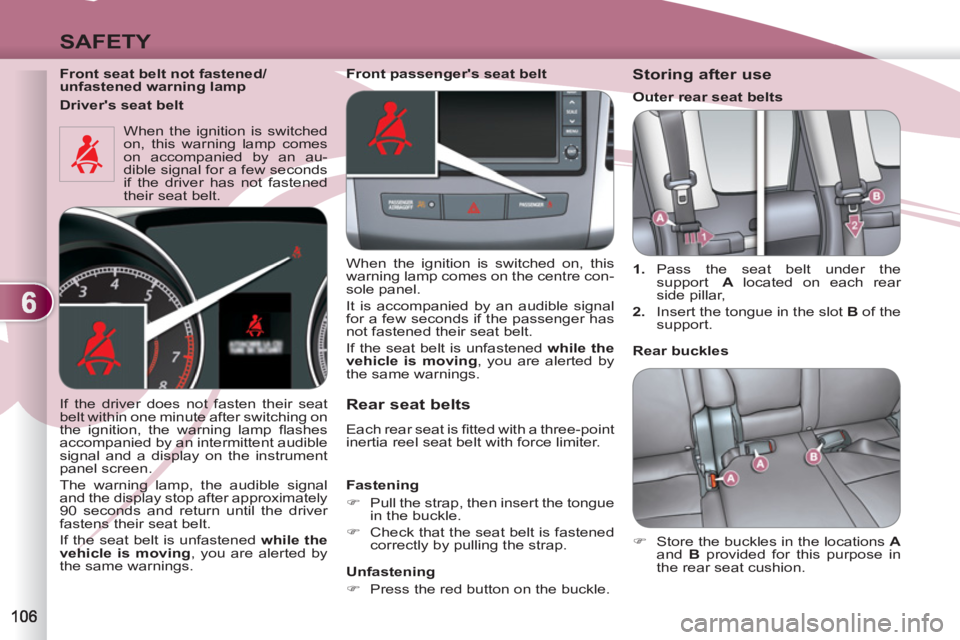
6
SAFETY
Front seat belt not fastened/
unfastened warning lamp
When the ignition is switched
on, this warning lamp comes
on accompanied by an au-
dible signal for a few seconds
if the driver has not fastened
their seat belt.
Rear seat belts
Each rear seat is fi tted with a three-point
inertia reel seat belt with force limiter.
Fastening
�)
Pull the strap, then insert the tongue
in the buckle.
�)
Check that the seat belt is fastened
correctly by pulling the strap.
Unfastening
�)
Press the red button on the buckle.
If the driver does not fasten their seat
belt within one minute after switching on
the ignition, the warning lamp fl ashes
accompanied by an intermittent audible
signal and a display on the instrument
panel screen.
The warning lamp, the audible signal
and the display stop after approximately
90 seconds and return until the driver
fastens their seat belt.
If the seat belt is unfastened while the
vehicle is moving
, you are alerted by
the same warnings.
Storing after use
1.
Pass the seat belt under the
support A
located on each rear
side pillar,
2.
Insert the tongue in the slot B
of the
support.
Rear buckles
�)
Store the buckles in the locations A
and B
provided for this purpose in
the rear seat cushion.
Front passenger's seat belt
When the ignition is switched on, this
warning lamp comes on the centre con-
sole panel.
It is accompanied by an audible signal
for a few seconds if the passenger has
not fastened their seat belt.
If the seat belt is unfastened while the
vehicle is moving
, you are alerted by
the same warnings.
Driver's seat belt
Outer rear seat belts
Page 111 of 236
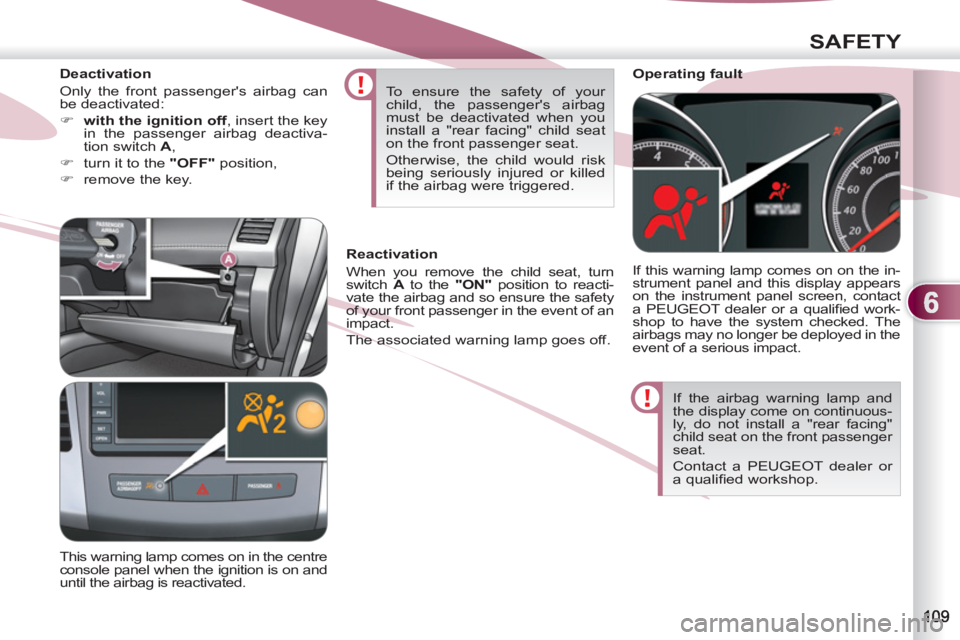
6
SAFETY
If the airbag warning lamp and
the display come on continuous-
ly, do not install a "rear facing"
child seat on the front passenger
seat.
Contact a PEUGEOT dealer or
a qualifi ed workshop.
Operating fault
If this warning lamp comes on on the in-
strument panel and this display appears
on the instrument panel screen, contact
a PEUGEOT dealer or a qualifi ed work-
shop to have the system checked. The
airbags may no longer be deployed in the
event of a serious impact. To ensure the safety of your
child, the passenger's airbag
must be deactivated when you
install a "rear facing" child seat
on the front passenger seat.
Otherwise, the child would risk
being seriously injured or killed
if the airbag were triggered.
This warning lamp comes on in the centre
console panel when the ignition is on and
until the airbag is reactivated.
Reactivation
When you remove the child seat, turn
switch A
to the "ON"
position to reacti-
vate the airbag and so ensure the safety
of your front passenger in the event of an
impact.
The associated warning lamp goes off.
Deactivation
Only the front passenger's airbag can
be deactivated:
�)
with the ignition off
, insert the key
in the passenger airbag deactiva-
tion switch A
,
�)
turn it to the "OFF"
position,
�)
remove the key.
Page 112 of 236
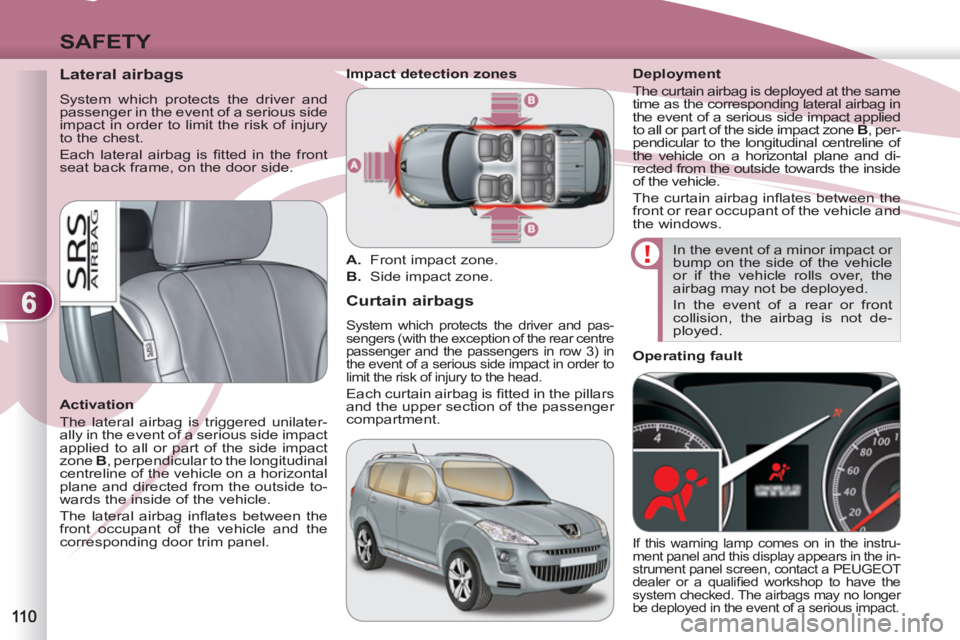
6
SAFETY
Lateral airbags
System which protects the driver and
passenger in the event of a serious side
impact in order to limit the risk of injury
to the chest.
Each lateral airbag is fi tted in the front
seat back frame, on the door side.
Activation
The lateral airbag is triggered unilater-
ally in the event of a serious side impact
applied to all or part of the side impact
zone B
, perpendicular to the longitudinal
centreline of the vehicle on a horizontal
plane and directed from the outside to-
wards the inside of the vehicle.
The lateral airbag infl ates between the
front occupant of the vehicle and the
corresponding door trim panel.
Curtain airbags
System which protects the driver and pas-
sengers (with the exception of the rear centre
passenger and the passengers in row 3) in
the event of a serious side impact in order to
limit the risk of injury to the head.
Each curtain airbag is fi tted in the pillars
and the upper section of the passenger
compartment.
Deployment
The curtain airbag is deployed at the same
time as the corresponding lateral airbag in
the event of a serious side impact applied
to all or part of the side impact zone B
, per-
pendicular to the longitudinal centreline of
the vehicle on a horizontal plane and di-
rected from the outside towards the inside
of the vehicle.
The curtain airbag infl ates between the
front or rear occupant of the vehicle and
the windows.
In the event of a minor impact or
bump on the side of the vehicle
or if the vehicle rolls over, the
airbag may not be deployed.
In the event of a rear or front
collision, the airbag is not de-
ployed.
Impact detection zones
A.
Front impact zone.
B.
Side impact zone.
Operating fault
If this warning lamp comes on in the instru-
ment panel and this display appears in the in-
strument panel screen, contact a PEUGEOT
dealer or a qualifi ed workshop to have the
system checked. The airbags may no longer
be deployed in the event of a serious impact.
Page 114 of 236
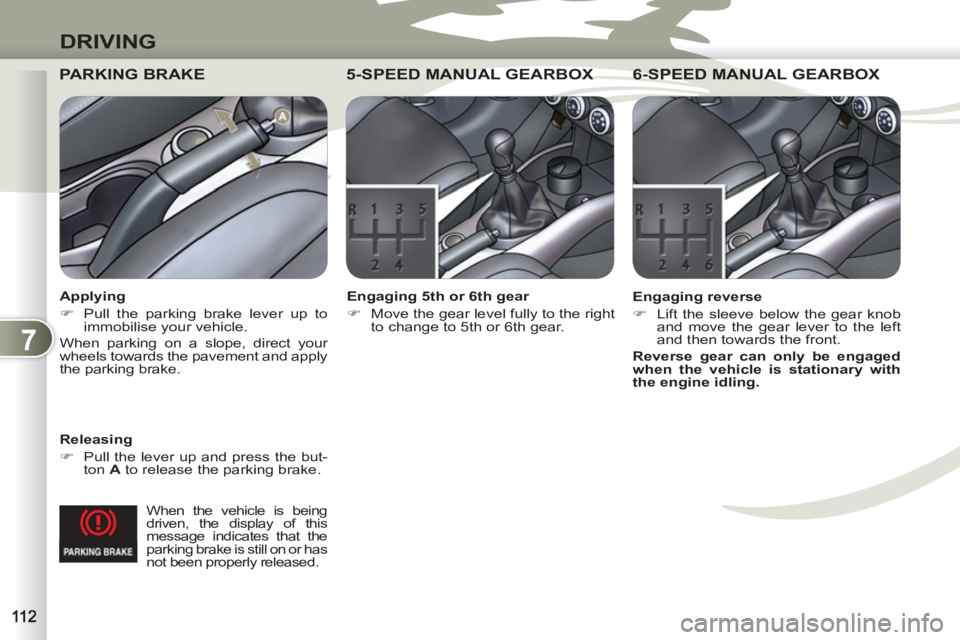
7
DRIVING
When the vehicle is being
driven, the display of this
message indicates that the
parking brake is still on or has
not been properly released.
PARKING BRAKE
Releasing
�)
Pull the lever up and press the but-
ton A
to release the parking brake.
NUAL GEARBOX
5-SPEED MANUAL GEARBOX
Engaging 5 th or 6 th gear
�)
Move the gear level fully to the right
to change to 5 th or 6 th gear.
Applying
�)
Pull the parking brake lever up to
immobilise your vehicle.
When parking on a slope, direct your
wheels towards the pavement and apply
the parking brake.
6-SPEED MANUAL GEARBOX6-SPEED MANUA
Engaging reverse
�)
Lift the sleeve below the gear knob
and move the gear lever to the left
and then towards the front.
Reverse gear can only be engaged
when the vehicle is stationary with
the engine idling.
Page 116 of 236
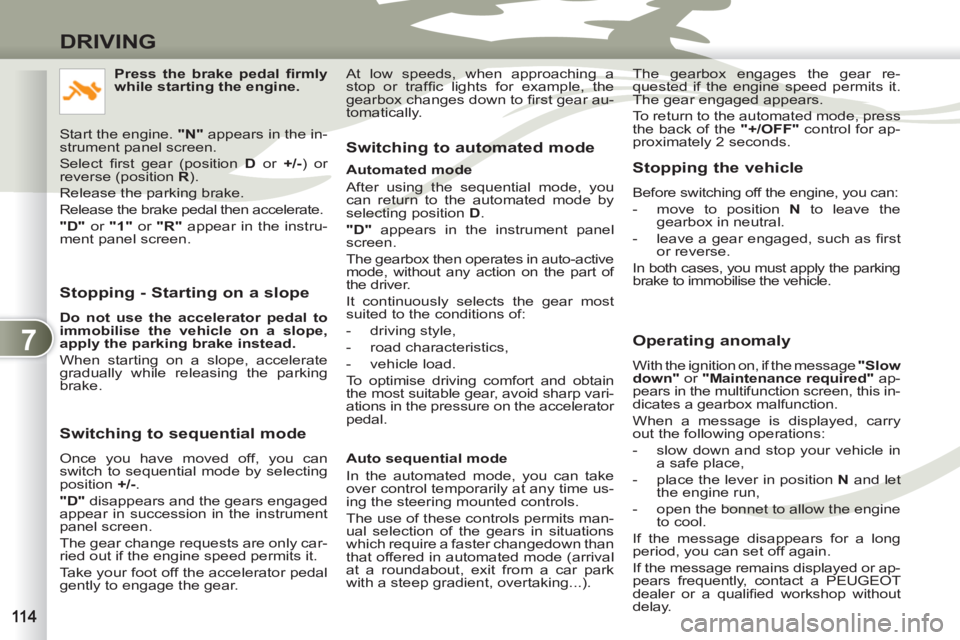
7
DRIVING
Stopping - Starting on a slope
Do not use the accelerator pedal to
immobilise the vehicle on a slope,
apply the parking brake instead.
When starting on a slope, accelerate
gradually while releasing the parking
brake.
Switching to sequential mode
Once you have moved off, you can
switch to sequential mode by selecting
position +/-
.
"D"
disappears and the gears engaged
appear in succession in the instrument
panel screen.
The gear change requests are only car-
ried out if the engine speed permits it.
Take your foot off the accelerator pedal
gently to engage the gear.
Switching to automated mode
Automated mode
After using the sequential mode, you
can return to the automated mode by
selecting position D
.
"D"
appears in the instrument panel
screen.
The gearbox then operates in auto-active
mode, without any action on the part of
the driver.
It continuously selects the gear most
suited to the conditions of:
- driving style,
- road characteristics,
- vehicle load.
To optimise driving comfort and obtain
the most suitable gear, avoid sharp vari-
ations in the pressure on the accelerator
pedal.
Auto sequential mode
In the automated mode, you can take
over control temporarily at any time us-
ing the steering mounted controls.
The use of these controls permits man-
ual selection of the gears in situations
which require a faster changedown than
that offered in automated mode (arrival
at a roundabout, exit from a car park
with a steep gradient, overtaking...).
Stopping the vehicle
Before switching off the engine, you can:
- move to position N
to leave the
gearbox in neutral.
- leave a gear engaged, such as fi rst
or reverse.
In both cases, you must apply the parking
brake to immobilise the vehicle.
Operating anomaly
With the ignition on, if the message "Slow
down"
or "Maintenance required"
ap-
pears in the multifunction screen, this in-
dicates a gearbox malfunction.
When a message is displayed, carry
out the following operations:
- slow down and stop your vehicle in
a safe place,
- place the lever in position N
and let
the engine run,
- open the bonnet to allow the engine
to cool.
If the message disappears for a long
period, you can set off again.
If the message remains displayed or ap-
pears frequently, contact a PEUGEOT
dealer or a qualifi ed workshop without
delay.
Press the brake pedal fi rmly
while starting the engine.
Start the engine. "N"
appears in the in-
strument panel screen.
Select fi rst gear (position D
or +/-
) or
reverse (position R
).
Release the parking brake.
Release the brake pedal then accelerate.
"D"
or "1"
or "R"
appear in the instru-
ment panel screen. The gearbox engages the gear re-
quested if the engine speed permits it.
The gear engaged appears.
To return to the automated mode, press
the back of the "+/OFF"
control for ap-
proximately 2 seconds.
At low speeds, when approaching a
stop or traffi c lights for example, the
gearbox changes down to fi rst gear au-
tomatically.
Page 117 of 236
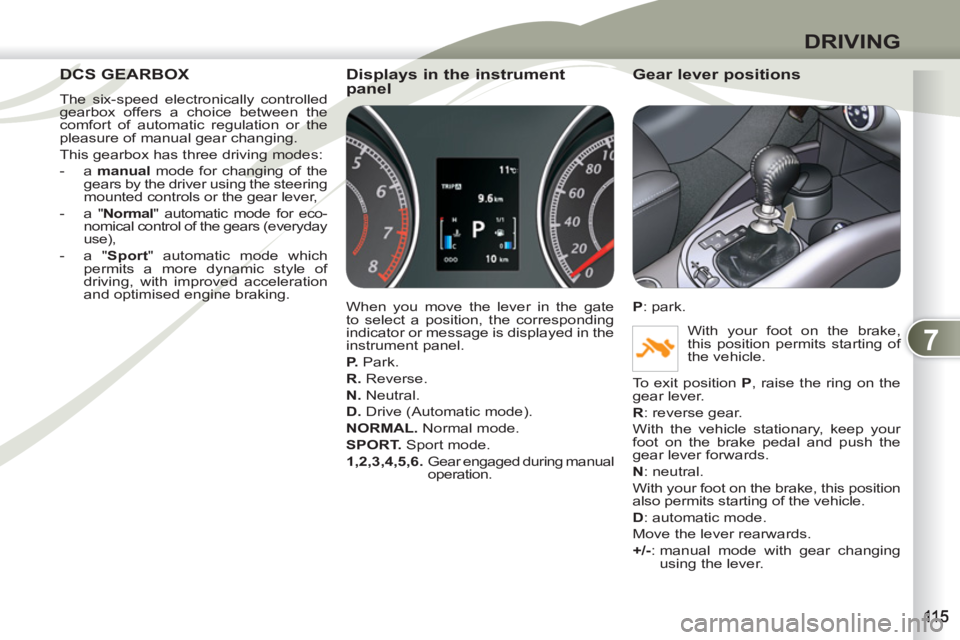
7
DRIVING
DCS GEARBOX DCS GEA
The six-speed electronically controlled
gearbox offers a choice between the
comfort of automatic regulation or the
pleasure of manual gear changing.
This gearbox has three driving modes:
- a manual
mode for changing of the
gears by the driver using the steering
mounted controls or the gear lever,
- a " Normal
" automatic mode for eco-
nomical control of the gears (everyday
use),
- a " Sport
" automatic mode which
permits a more dynamic style of
driving, with improved acceleration
and optimised engine braking.
Displays in the instrument
panel
When you move the lever in the gate
to select a position, the corresponding
indicator or message is displayed in the
instrument panel.
P.
Park.
R.
Reverse.
N.
Neutral.
D.
Drive (Automatic mode).
NORMAL.
Normal mode.
SPORT.
Sport mode.
1,2,3,4,5,6.
Gear engaged during manual
operation.
Gear lever positions
P
: park.
With your foot on the brake,
this position permits starting of
the vehicle.
To exit position P
, raise the ring on the
gear lever.
R
: reverse gear.
With the vehicle stationary, keep your
foot on the brake pedal and push the
gear lever forwards.
N
: neutral.
With your foot on the brake, this position
also permits starting of the vehicle.
D
: automatic mode.
Move the lever rearwards.
+/-
: manual mode with gear changing
using the lever.
Page 120 of 236

7
DRIVING
Operating fault
Reverse gear
Flashing of the indicator R
in the instru-
ment panel screen, accompanied by an
audible signal, indicates a malfunction
on engaging the gear:
Press the brake pedal, position the gear
lever in position N
and engage reverse
gear again.
With the ignition on, if this warning light
comes on, accompanied by vibration
in the pedals and the message "Main-
tenance required"
on the instrument
panel display, this indicates a gearbox
malfunction.
If the message is displayed, carry out
the following operations:
- slow down and stop your vehicle in
a safe place,
- place the lever in position P
or N
,
apply the parking brake and let the
engine run,
- open the bonnet to allow the engine
to cool.
If the message disappears for a long
period, you can set off again.
If the message remains displayed or ap-
pears frequently, contact a PEUGEOT
dealer or a qualifi ed workshop without
delay.
Overheating of the engine may re-
sult in unwanted declutching of the
gearbox.